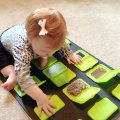Toddlers are at an age where they are learning to identify and express their emotions, but sometimes they struggle to find the words to do so (and boy, don’t we know it as parents!). This is where emotion flash cards can come in handy!
I’m so pleased to be able to share with the readers of Montessori Tips exclusive access to our FREE printable emotion cards (coming soon)!
Through this article, I’ll explore how you can use our free printable emotions and feelings flashcards to help your toddler express their feelings. I’ll include three fun activities to do with your child using the cards to get you started, too!
Why Emotion Flash Cards Are Important
Emotion flash cards are a great tool for helping toddlers learn to identify and express their emotions.
According to research, toddlers experience a wide range of emotions, and it is important to help them learn to identify and express their feelings in a healthy and appropriate way.
Some of the most common emotions that toddlers may need to express include:
- Happiness: Toddlers often express happiness through smiles, laughter, and giggles. It is important to encourage and celebrate their positive emotions.
- Sadness: Toddlers may express sadness through crying, pouting, or withdrawing from social interactions. It is important to validate their feelings and provide comfort and support.
- Anger: Toddlers may express anger through tantrums, hitting, or throwing objects. It is important to set appropriate limits and boundaries while also teaching them healthy ways to express their anger.
- Fear: Toddlers may express fear through clinging, crying, or hiding. It is important to acknowledge their fears and provide reassurance and comfort.
- Frustration: Toddlers may express frustration through whining, stomping, or throwing tantrums. It is important to help them learn problem-solving skills and encourage persistence in the face of challenges.
- Curiosity: Toddlers may express curiosity through exploration, questioning, and experimentation. It is important to encourage their natural curiosity and provide opportunities for learning and discovery.
- Love: Toddlers may express love through hugs, kisses, and affectionate gestures. It is important to show them love and affection in return and foster healthy attachment relationships.
By using emotion flashcards, you can help your child:
- Learn new vocabulary: By introducing your child to new emotions, you can expand their emotional vocabulary and help them articulate their feelings more clearly.
- Understand different emotions: By discussing the different emotions depicted on the cards, you can help your child understand what each emotion means and when they might feel it.
- Express their own emotions: By encouraging your child to use the cards to express how they feel, you can help them develop the skills to express their emotions in a healthy and appropriate way.

What Role do Feelings Flashcards Play in a Montessori home?
The use of emotion flashcards aligns well with the Montessori philosophy! Montessori principles emphasize the importance of following the child’s interests and needs, providing opportunities for self-directed learning, promoting independence and self-awareness.
By using emotion flashcards, you give your child the opportunity to recognize and understand their emotions, an important step towards self-awareness.
There’s other added benefits of using flashcards, like your little one building their vocabulary, improving their communication skills, and learning how to express their feelings in healthy ways.
When practising Montessori at home, we encourage you to create a prepared environment that fosters independence, exploration, and discovery. The use of emotion flashcards can be incorporated into this environment by setting up a designated area for the cards (I suggest a chart using velcro-dots placed low enough to be at your child’s eye level), allowing children to access them independently, and letting them explore and play with them in a self-directed way, as well as using some of the activities I outline further down.
What the Benefits of Using Feelings Flashcards?
Improved Emotional Intelligence
Emotion flash cards can help toddlers develop emotional intelligence, which is the ability to understand and manage one’s emotions. By learning to identify and express different emotions, toddlers can improve their emotional intelligence, which can have long-term benefits in both their personal and professional lives.
Better Communication Skills
Using emotion flash cards can also help toddlers develop better communication skills. By learning to express their emotions, toddlers can communicate their needs more effectively, which can help prevent frustration and tantrums.
Increased Empathy
Emotion flash cards can also help toddlers develop empathy, which is the ability to understand and share the feelings of others. By learning about different emotions, toddlers can develop a greater understanding of how others may be feeling and learn to respond appropriately.
How to Use Emotion and Feelings Flashcards
Using emotion flashcards with toddlers is easy and can be incorporated into your daily routine. Here are some ideas to get you started:
Introduce the Cards
To introduce the cards to your toddler, start by displaying them one at a time and identifying the emotion shown. Ask your child if they recognize the emotion and if they have ever felt that way before. You can then discuss what might cause someone to feel that particular emotion and ask your toddler if they can think of any situations where they might have experienced that feeling.
Practice Expressing Emotions
Encourage your child to practice expressing different emotions by making faces or using body language. For example, if you show them the card for “happy,” ask them to show you their “happy face” and talk about things that make them happy. As your toddler becomes more familiar with the emotions on the cards, you can start using them to help your child regulate their own emotions. For example, if your child is feeling frustrated, you can show them the card with the emotion of “frustration” and talk about ways to cope with that feeling. You can also encourage your child to choose their own card to show how they are feeling and then work together to come up with strategies for managing their emotions.
Use Real-Life Examples
Use real-life examples to help your child understand different emotions. For example, if your child is feeling sad, show them the card for “sad” and talk about why they might be feeling that way. You can also provide examples of things that make you feel sad and discuss how you cope with those emotions.
Play Games (keep reading for 3 activity ideas)
Make learning about emotions fun by playing games with your child. For example, you can lay out several emotion flash cards and ask your child to find the card that matches how they are feeling. Or, you can play a guessing game where you make a face or use body language to express an emotion, and your child has to guess which emotion you are expressing.
Keep it Simple
When using emotion flash cards with toddlers, it’s important to keep things simple. Use basic emotions like happy, sad, angry, and scared, and avoid using complex emotions like jealousy or embarrassment.
How to use emotion cards at home: 3 activities you can try with your toddler
Activity 1, Emotion Match-Up, is a simple matching game that can help your child recognize different emotions and associate them with facial expressions.
Activity 2, Emotion Charades, takes things a step further by encouraging your child to act out different emotions and guess what emotion they are portraying.
Finally, Activity 3, Emotion Storytelling, helps your child develop their storytelling skills while exploring different emotions and perspectives.
Activity 1: Emotion Match-Up
Suitable for ages 1-3
In this activity, your child will learn to match the emotion word to the correct emotion picture on the flash cards.
Instructions:
- Spread out the emotion flash cards on a table or on the floor.
- Say the name of an emotion out loud (e.g. “happy”).
- Ask your child to find the card that matches the emotion you said.
- If your child selects the correct card, praise them and ask them to name the emotion.
- Repeat steps 2-4 with different emotions until your child has matched all the cards correctly.
Aims:
This activity aims to help your child learn to identify different emotions and connect the emotion word with the corresponding picture.
Activity 2: Emotion Charades
Suitable for ages 2-4
In this activity, your child will learn to act out emotions using the emotion flash cards.
Instructions:
- Shuffle the emotion flash cards and place them in a pile face-down.
- Ask your child to pick a card from the pile without showing it to you.
- Ask your child to act out the emotion depicted on the card (e.g. if the card shows “angry”, your child might cross their arms and frown).
- Try to guess the emotion your child is acting out.
- Take turns picking cards and acting out emotions.
Aims:
This activity aims to help your child learn to express emotions through body language and facial expressions, and to develop empathy by recognizing and guessing other people’s emotions.
Activity 3: Emotion Storytelling
Suitable for ages 3-4
In this activity, your child will learn to use the emotion flash cards to tell a story about different emotions.
Instructions:
- Shuffle the emotion flash cards and place them in a pile face-down.
- Ask your child to pick three cards from the pile without showing them to you.
- Ask your child to use the three cards to tell a story about a character who experiences each of the emotions depicted on the cards (e.g. “Once upon a time, there was a bear who was very happy because he found a big jar of honey. But then he got scared because he heard a loud noise outside. Finally, he felt relieved when he saw that it was just a bird.”)
- Encourage your child to use their imagination and make up their own stories.
- Encourage your child to use their imagination and make up their own stories.
- After your child has told their story, ask them how they think the character felt at each stage of the story, and how they would feel if they were in that situation.
- Repeat the activity with different combinations of cards to create new stories.
Aims:
- Develop their language and storytelling skills
- Recognize and understand different emotions and how they can change over time
- Explore different perspectives and develop empathy by imagining how characters in the stories might feel.
By playing these activities with your child, you can help them build their emotional intelligence and give them tools to navigate their feelings in a healthy and constructive way. Remember, learning to express and understand emotions is a lifelong journey, and it’s important to give your child the support and encouragement they need along the way.
Other Resources to Support Your Toddler’s Emotional Development
While emotion flashcards can be a helpful tool in teaching toddlers about emotions, it’s super important to remember that they don’t replace your little one’s need emotional support and validation from YOU!
Acknowledge and validate your child’s emotions as they arise, even if they are difficult or uncomfortable.
When children feel seen, heard, and understood, they are better able to regulate their emotions and develop healthy emotional coping skills. Hard work in these early years will pay off in the future, so hang in there with your little one is having a hard time with their “big feelings”.
In addition to using emotion flash cards, there are other ways to help your toddler develop emotional intelligence. You can read books together that explore emotions, such as “The Way I Feel” by Janan Cain or “The Color Monster” by Anna Llenas. You can also model healthy emotional expression and regulation by talking about your own emotions and how you cope with them. Encouraging your toddler to engage in imaginative play can also be beneficial, as it allows them to explore different emotions and scenarios in a safe and creative environment.
The Bottom Line
Using emotions flash cards can be a fun and engaging way to help your child learn about their emotions. By incorporating feelings flashcard activities into your regular playtime, you can help your child develop their emotional intelligence, language and storytelling skills, and empathy. As always, it’s important to follow your child’s lead and let them guide the play. With time and practice, your child will become more confident in expressing and understanding their emotions, and you’ll be there to support them every step of the way.








